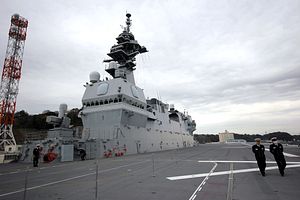U.S. Marine Corps F-35B fighter jets will operate off a Japanese warship this fall, a significant step in the ability of the two militaries to work together and potentially a critical capability in hypothetical crises with China over Taiwan or Japan’s southwestern islands.
General David Berger, the Marines commandant, revealed the plan at a conference this week.
In 2019, USNI News reported that the Abe Shinzo government in Japan had approached the U.S. Marines about the possibility of operating their jets from two of its large helicopter assault ships, though neither ship had yet begun the deck-strengthening modifications that it would require.
Japan euphemistically calls its large amphibious carriers “helicopter destroyers” because aircraft carriers are more often associated with offensive military operations. The two most modern, the Kaga and the Izumo, are being modified to accommodate F-35B fighters, which have a vertical or short take-off capability and can be launched from short flight decks without the assistance of catapult systems. The trade-off for this capability is that the jets have a shorter flight endurance and can carry less armament when not launched from catapults.
Despite Japan’s insistence that the ships were not true aircraft carriers when they were built, the euphemism was belied when the Izumo’s sister-ship was named – the first Kaga was a famous aircraft carrier in the old Imperial navy, taking part in the attack on Pearl Harbor and later scuttled after being damaged at the battle of Midway in 1942.
The Izumo’s modifications were completed earlier this summer and so it is the ship likely to receive the U.S. jets. Kaga’s modifications are set to begin at the end of this year.
Although they lack the range and firepower of the air wings that the United States’ nuclear-powered supercarriers can accommodate, Japan’s small carriers are well-suited to the archipelagic operational environment around its home islands.
In a potential conflict between China and Japan over disputed islands in the East China Sea that draws in the United States – which is treaty-bound to help Japan defend its territory, including the disputed Senkaku islands – or a much broader conflict with Taiwan that draws in Japan, the ability of U.S. jets to supplement Japanese air wings or to utilize Japanese decks could be a significant asset.
China’s accelerating military edge and bellicose rhetoric toward both Japan and Taiwan has prompted Japanese leaders to begin speaking more publicly about its strategic interest in maintaining the island’s independence. To access the wider western Pacific, Chinese warships must now pass through the narrow straits between Japan’s Ryukyu islands. If China took control of Taiwan, its fleets and air force would have more direct access to Japan’s eastern flank in a potential conflict.
Japan and Taiwan held their first joint security talks at the end of August. While Japan and Taiwan do not have official diplomatic ties, senior lawmakers from each side discussed China’s encroaching and increasingly aggressive military activities in the region and potential military cooperation, to include the United States.
In a broad fight over Taiwan’s fate, the United States’ more potent aircraft carriers would likely be engaged in deep strikes against naval targets inside the so-called first island chain, while U.S. Marines and Japan’s Self-Defense Forces would probably focus on defending those islands to prevent Chinese warships and submarines from “breaking out” into the Pacific. The ability for U.S. Marine Corps aviation to operate from Japanese ships could provide crucial flexibility to the allies in that scenario.

































